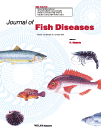Monitoring Farmed Fish Welfare by Measurement of Cortisol as a Stress Marker in Fish Feces by Liquid Chromatography Coupled with Tandem Mass Spectrometry

Abstract
The aquaculture industry has become a sustainable source of food for humans. Remaining challenges include disease issues and ethical concerns for the discomfort and stress of farmed fish. There is a need for reliable biomarkers to monitor welfare in fish, and the stress hormone cortisol has been suggested as a good candidate. This study presents a novel method for measurement of cortisol in fish feces based on enzymatic hydrolysis, liquid–liquid extraction, derivatization, and finally instrumental analysis by liquid chromatography coupled with tandem mass spectrometry. Hydrolysis and extraction conditions were optimized. Cortisol appeared to be mostly conjugated to sulfate and less conjugated to glucuronic acid in the studied samples of feces from farmed Atlantic salmon. The method was suitable for quantification of cortisol after enzymatic deconjugation by either combined glucuronidase and sulfatase activity, or by glucuronidase activity alone. The limit of detection was 0.15 ng/g, the limit of quantification was 0.34 ng/g, and the method was linear (R2 > 0.997) up to 380 ng/g, for measurement of cortisol in wet feces. Method repeatability and intermediate precision were acceptable, both with a coefficient of variation (CV) of 11%. Stress level was high in fish released into seawater, and significantly reduced after eight days.
